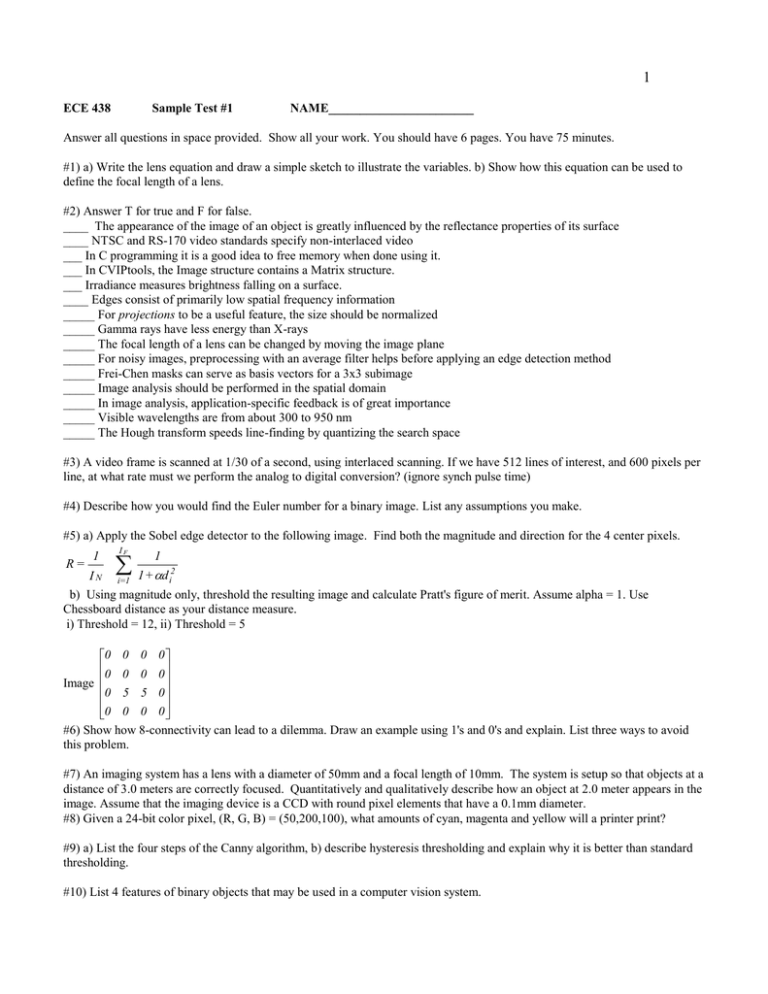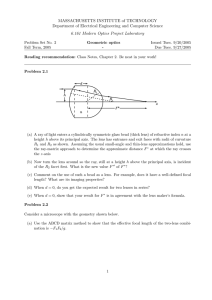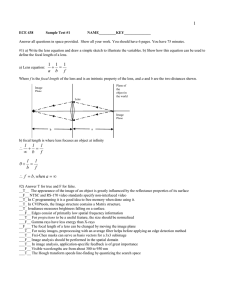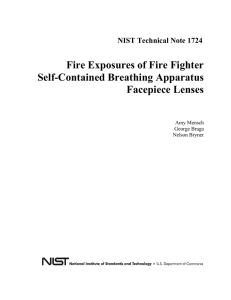Sample test,
advertisement

1 ECE 438 Sample Test #1 NAME_______________________ Answer all questions in space provided. Show all your work. You should have 6 pages. You have 75 minutes. #1) a) Write the lens equation and draw a simple sketch to illustrate the variables. b) Show how this equation can be used to define the focal length of a lens. #2) Answer T for true and F for false. ____ The appearance of the image of an object is greatly influenced by the reflectance properties of its surface ____ NTSC and RS-170 video standards specify non-interlaced video ___ In C programming it is a good idea to free memory when done using it. ___ In CVIPtools, the Image structure contains a Matrix structure. ___ Irradiance measures brightness falling on a surface. ____ Edges consist of primarily low spatial frequency information _____ For projections to be a useful feature, the size should be normalized _____ Gamma rays have less energy than X-rays _____ The focal length of a lens can be changed by moving the image plane _____ For noisy images, preprocessing with an average filter helps before applying an edge detection method _____ Frei-Chen masks can serve as basis vectors for a 3x3 subimage _____ Image analysis should be performed in the spatial domain _____ In image analysis, application-specific feedback is of great importance _____ Visible wavelengths are from about 300 to 950 nm _____ The Hough transform speeds line-finding by quantizing the search space #3) A video frame is scanned at 1/30 of a second, using interlaced scanning. If we have 512 lines of interest, and 600 pixels per line, at what rate must we perform the analog to digital conversion? (ignore synch pulse time) #4) Describe how you would find the Euler number for a binary image. List any assumptions you make. #5) a) Apply the Sobel edge detector to the following image. Find both the magnitude and direction for the 4 center pixels. R= 1 IF 1 +d 1 2 I N i=1 i b) Using magnitude only, threshold the resulting image and calculate Pratt's figure of merit. Assume alpha = 1. Use Chessboard distance as your distance measure. i) Threshold = 12, ii) Threshold = 5 0 0 0 0 0 0 0 0 Image 0 5 5 0 0 0 0 0 #6) Show how 8-connectivity can lead to a dilemma. Draw an example using 1's and 0's and explain. List three ways to avoid this problem. #7) An imaging system has a lens with a diameter of 50mm and a focal length of 10mm. The system is setup so that objects at a distance of 3.0 meters are correctly focused. Quantitatively and qualitatively describe how an object at 2.0 meter appears in the image. Assume that the imaging device is a CCD with round pixel elements that have a 0.1mm diameter. #8) Given a 24-bit color pixel, (R, G, B) = (50,200,100), what amounts of cyan, magenta and yellow will a printer print? #9) a) List the four steps of the Canny algorithm, b) describe hysteresis thresholding and explain why it is better than standard thresholding. #10) List 4 features of binary objects that may be used in a computer vision system. 2 #11) a) Approximately how many electrons are liberated if: irradiation = 100,000 photon flux/nm2 quantum efficiency of device = 0.05 electron flux/photon flux area = 50 nm2 time period = 10 milliseconds the photon flux is bandlimited to visible wavelengths b) Is this a tube or solid state device? Explain. #12) Consider the imaging situation in the figure. Find a and b so that a 50mm focal length lens will correctly focus the object onto the image plane. IMAGE PLANE LENS OBJECT | L O | L O | L O | L O |<--------- a ----------->L <------- b -----> O |<----------------------200 mm----------------> #13) a)Give examples of the coefficients of these 3x3 spatial convolution filters: 1) mean, 2) enhancement; b) are these linear filters? #14) Use first-order hold to zoom the image to approximately twice the size: 6 8 4 6 4 8 5 5 3 #15 )a) Find the Frei-Chen mask weights for the following 3x3 image: 1 0 1 1 0 1 1 0 1 b) Show how we obtain the image back using these weights.







